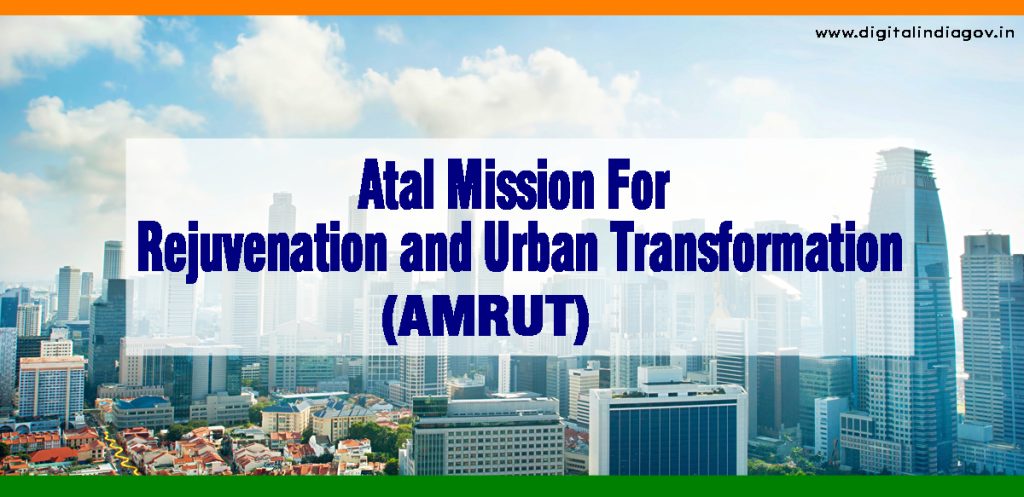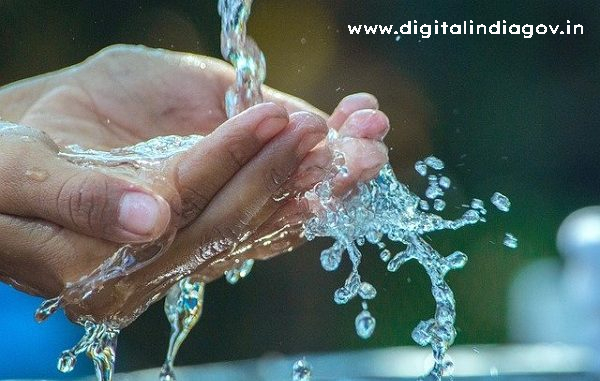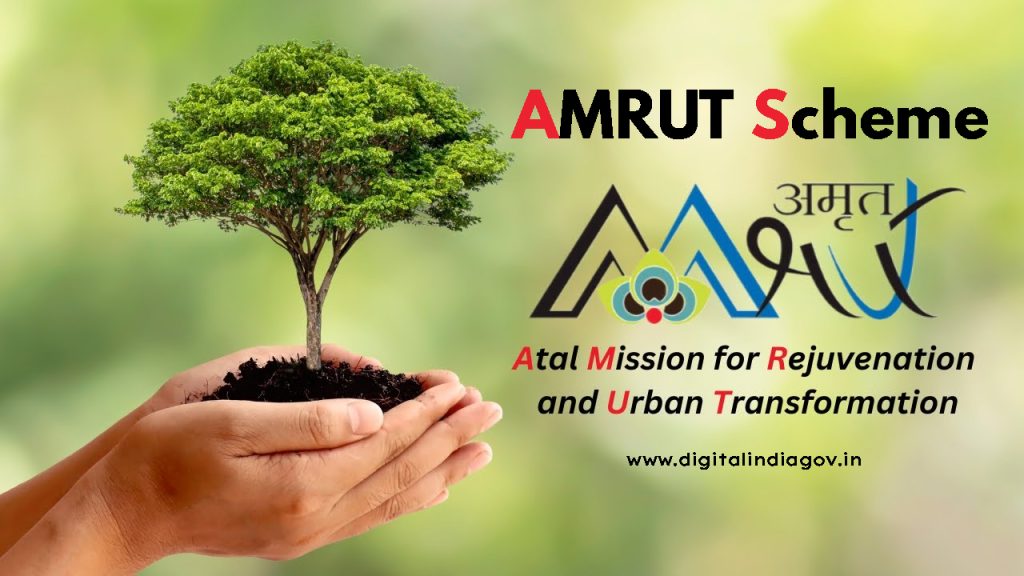AMRUT Scheme:- AMRUT stands for Atal Mission for Rejuvenation and Urban Transformation. It’s a nationwide initiative for urban regeneration. The Indian government introduced this in 2015. The program attempts to raise the standard of living in cities. It offers necessities including stormwater drainage, sewerage, and water delivery. Additionally, it promotes public transportation and green spaces in an effort to enhance the urban environment.
Contents
What is Amrut’s Mission?
June 25, 2015, saw the commencement of the Amrut plan. In accordance with the Public-Private Partnership, it is under the jurisdiction of the Indian government’s Ministry of Housing and Urban Affairs (PPP). As per the Atal Mission for Urban Transformation and Rejuvenation,
| AMRUT At Glance | |
| Amrut scheme Full Form | Atal Mission for Rejuvenation and Urban Transformation |
| Launched | 25 June 2015 |
| Ministry | Ministry of Housing and Urban Affairs |
| Purpose | Urban Transformation |

Also Read:- UP Scholarship, Digitize India, Digitize India Platform, Work From Home Jobs, Celebrity Phone Number
Highlights of the AMRUT Scheme
AMRUT seeks to provide urban mobility, sewage treatment, and water delivery to buildings and homes in urban areas. It is a national priority because it will raise everyone’s quality of life, especially that of the underprivileged and impoverished. In compliance with AMRUT, five hundred cities have been selected. These are the cities that have been selected under AMRUT.
- All capital cities and towns of states and union territories not already mentioned above, as well as all cities and towns with a population of more than one lakh and notified municipalities as of the 2011 Census, including cantonment boards (civilian areas).
- Every city or town that MoHUA has designated as a Heritage City for the HRIDAY Programme.
- Thirteen cities and towns with a population of more than 75,000 but less than one lakh are located along the main rivers’ stems.
- Ten cities (not more than one from each state) representing hill states, islands, and tourism attractions.
So Far Developments of the AMRUT Mission
- The AMRUT initiative has made it possible to replace streetlights and connect homes to water taps and sewers. The plan has provided:
- 88 lakh streetlight replacements,
- 78 lakh sewer connections, and
- 105 lakh residential water tap connections.
- The program has reduced the carbon footprint by 84.6 lakh tonnes.
- The first place goes to Odisha, then to Chandigarh in terms of AMRUT implementation.
- Punjab, Himachal Pradesh, Uttarakhand, Haryana, and Himachal Pradesh are also making headway with the scheme’s implementation.
- The OBPS system is being used in the mission cities of Uttarakhand and Himachal Pradesh.
- Both states have requested initiatives related to the “Catch the Rain” campaign.
Objectives of the AMRUT Scheme
Below is a list of the Amrut scheme’s objectives.
- Access to a Sewage Connection and Tap Water: To guarantee that every family has a sewerage connection and a tap that provides a reliable supply of water.
- Keeping Greenery Alive: To raise the amenity value of cities by creating parks and other well-kept open spaces
- reduction of pollution through the use of public transportation or the construction of non-motorized transportation infrastructure (e.g. walking and cycling).
- Establishing Service Level Benchmarks (SLBs): The public, particularly women, greatly value all of these outcomes, and the Ministry of Housing and Urban Affairs (MoHUA) has developed indicators and standards in the form of SLBs for each of them.
- Prerequisite Objective: Water supply and sewage are the mission’s priority zones.
Components of AMRUT Mission
Building capacity, implementing reforms, managing stormwater drainage, urban transportation, water supply, sewage and septage, and the creation of parks and green areas are all parts of the AMRUT. Incorporating smart elements into physical infrastructure components will be a priority for Urban Local Bodies (ULBs) as they plan. Here’s a more thorough explanation of every component.

Also Read:- Antyodaya Anna Yojana
Eligibility for Amrut Mission
To be eligible for the Atal Mission for Rejuvenation and Urban Transformation program, one must meet the requirements listed below:
- Cities and towns with a population of more than one lakh (100,000) according to the 2011 census are eligible for the AMRUT project.
- States’ and union territories’ capital cities are also eligible for the AMRUT program.
- The Ministry of Housing and Urban Affairs has designated heritage cities that qualify for the program.
- Cities on the banks of significant rivers are also eligible for the AMRUT program.
- Cities with a high potential for tourism are also eligible for the program.
Performance of AMRUT Phase I
- Home tap connections total 1.1 crore, while sewage or septage system connections total 85 lakh.
- Currently in use, 6,000 MLD of treated sewage can be recycled, leaving 977 MLD available for this purpose. from the sewage.
- To create 1,820 parks on 3,600 acres, another 1,800 acres are being planted with vegetation. There are currently 1,700 fewer flooding points.
- Forty-seven cities have had their credit ratings completed. Out of all of these cities, 184 have an Investable Grade Rated (IGR) of A- or higher, with 36 of them.
- The Ease of Doing Business index now ranks India higher.
AMRUT 2.0
On October 1, 2021, Prime Minister Narendra Modi introduced the AMRUT 2.0 program.
- The purpose of the Atal Mission for Rejuvenation and Urban Transformation 2.0 (AMRUT 2.0) is to increase the ease of living in the water sector from 500 to all statutory towns and to accomplish Sustainable Development Goal 6.
- Goal 6.4 of the Sustainable Development Agenda is to guarantee sustainable freshwater withdrawals, considerably lower the proportion of the population experiencing water scarcity, and greatly increase water usage efficiency across all sectors by 2030.
- It will also guarantee complete coverage for sewage and sewage control for all 500 AMRUT cities.
AMRUT Scheme – Latest Developments
- A total of Rs. 1 lakh crore was allocated for the Mission’s development when it was first announced on June 25, 2015. Of which, basic infrastructure projects costing Rs. 79,772 crores have been grounded in accordance with State action plans totaling Rs. 77,640 crores that were approved. As of June 2021, work totaling Rs. Fifty-two,477 crores, or 66%, had been finished.
- According to information made public by the Ministry of Housing and Urban Affairs (MoHUA) in June 2021, the program has advanced the following:
- Of the total capacity of 1,240 MLD that have been constructed, 907 MLD of Sewage Treatment Plants (STPs) are being recycled or repurposed. There is a fourth, 4,800 MLD STP capacity in development.
- Throughout 27 states and territories, 396 cities have completed water pump energy audits. 667 of the 11,385 water pumps that require replacement have previously been completed.
- In 2,465 towns, including 452 AMRUT cities, the Online Building Permission System (OBPS), which seamlessly integrates with internal and external agencies, has gone live. India’s position in the World Bank’s Report (DBR)-2020 on the Ease of Doing Business (EODB) for construction licenses has increased from 181 in 2018 to 27.

Also Read:- Indane Gas Booking
Who can apply for the Amrut Scheme?
The goal of the Atal Mission for Rejuvenation and Urban Transformation is to encompass about 500 cities with a population exceeding one lakh. In order for a city or town to be eligible for the AMRUT Scheme, they need to fulfill the following requirements:
- Any cities and towns with a population of one lakh or more as of the 2011 census, including civilian areas and notified municipalities.
- Every state or territory’s capital city or municipality that does not meet the aforementioned requirements.
- the towns or cities that the Ministry of Housing and Urban Affairs has designated as Heritage Cities under the HRIDAY Scheme.
- Thirteen towns and cities with a population of more than 75,000 but less than 1 lakh that are located along the main rivers’ stem.
- Ten cities that are popular tourist destinations, islands, and hill states. Each of these states may only have one city selected under the AMRUT program.
FAQ’s
Q. What is the scheme AMRUT?
Ans- The AMRUT program is an effort to improve the quality of life in urban areas by bringing basic municipal amenities to the underprivileged and impoverished. With 500 cities participating in its inception, it is the first targeted national water mission, encompassing 60% of the urban population.
Q. What new name did the AMRUT plan go by?
Ans- The Atal Mission for Rejuvenation and Urban Transformation (AMRUT) replaced the Jawaharlal Nehru National Urban Renewal Mission.
Suggested Link:- Our Jharkhand
@PAY
